MRI is currently the gold standard for identifying radicular pathology, but unfortunately, it requires preauthorization, which isn’t easy to obtain. Physical tests are what most practitioners depend on – despite the marginal reliability of the tests. The information in this article brings history and observation to the forefront of radicular diagnostics. Each factor listed can significantly increase the clinician’s ability to diagnose radiculopathies.
National Board Publishes New Job Analysis of Chiropractic
This page requires additional images, please allow time to download.
There is no more comprehensive survey of U.S. chiropractors and chiropractic patients than the Job Analysis of Chiropractic published by the National Board of Chiropractic Examiners (NBCE). Job Analysis was first published in 1993; in 1994, the NBCE released a companion volume that included a state-by-state statistical report on chiropractic practice. Now comes Job Analysis 2000, the largest and most comprehensive volume.
The project director, author and editor of all three volumes has been Mark Christensen,PhD, director of testing for the NBCE. To gather the necessary information for Job Analysis 2000, 9,244 U.S. doctors of chiropractic were selected from the 59,820 licensed DCs in 1998. The selection process was designed to provide reliable data at the state and national level.
Here is a sample of some of the more interesting findings of the 209-page Job Analysis 2000:
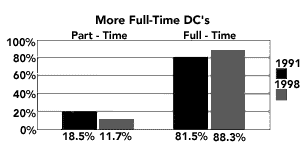
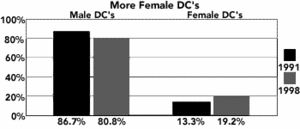

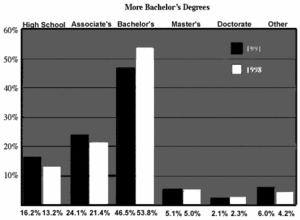
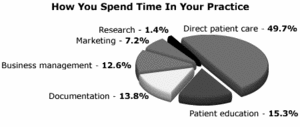
More Pediatric Patients
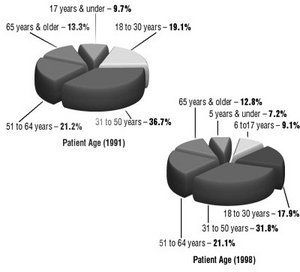
Most Utilized Adjustive Techniques / Procedures
| Adjustive | % of DC's Utilizing Technique / Procedure | | |
| | 1991 | 1998 | 1998 |
| Diverified | 91.1% | 95.9% | 73.5% |
| Extremity adjusting | no data | 95.5% | 47.8% |
| Activator Methods | 51.2% | 62.8% | 21.7% |
| Gonstead | 54.8% | 58.5% | 28.9% |
| Cox / Flexion - Distraction | 52.7% | 58.0% | 25.2% |
| Thompson | 43.0% | 55.9% | 25.8% |
| SOT | 41.3% | 49.0% | 16.5% |
| Applied Kinesiology | 37.2% | 43.2% | 14.5% |
| NIMMO / receptor tonus | 40.3% | 40.0% | 17.7% |
| Cranial | 27.2% | 37.3% | 11.2% |
| Adjustive instrument | no data | 34.5% | 14.0% |
| Palmer Upper Cervical / HIO | 26.0% | 28.8% | 9.1% |
| Logan Basic | 30.6% | 28.7% | 7.1% |
| Meric | 23.4% | 19.9% | 6.5% |
| Pierce- Stillwagon | 19.7% | 17.1% | 6.5% |
| Other | 15.0% | 14.8% | 9.9% |
Most Utilized Passive Adjunctive Care
| Passive Adjunctive Care | % of DC's Utilizing Technique / Procedure | % of Patients Receiving Technique / Procedure | |
| 1991 | 1998 | 1998 | |
| Ice pack / cryotherapy | 92.6% | 93.9% | 50.4% |
| Trigger-point therapy | no data | 90.9% | 47.7% |
| Nutritional counseling, therapy or supplements | 83.55% | 90.4% | 36.6% |
| Bracing with lumber support, cervical collar, etc. | 90.8% | 90.1% | 27.5% |
| Massage therapy | 73.0% | 83.0% | 37.4% |
| Hot pack / moist heat | 78.5% | 82.1% | 43.8% |
| Traction | 73.2% | 79.0% | 33.3% |
| Electrical stimulation / therapy | 73.2% | 76.2% | 44.9% |
| Bed rest | 82.0% | 75.7% | 17.5% |
| Heel lifts | 79.2% | 75.1% | 18.8% |
| Mobilization therapy | no data | 74.5% | 34.8% |
| Ultrasound | 68.8% | 70.3% | 34.3% |
| Acupressure or meridaian therapy | 65.5% | 66.1% | 28.5% |
| Homeopathic rememedies | 36.9% | 53.1% | 14.6% |
| Taping / strapping | 48.2% | 48.7% | 10.7% |
| Vibratory therapy | 42.0% | 44.1% | 20.8% |
| Direct current, electrodiagnosis | 26.9% | 25.9% | 10.1% |
| Diathermy - shortwave or microwave | 26.7% | 22.0% | 7.8% |
| Infrared - baker, heat lamp or hot pad | 19.0% | 17.5% | 7.0% |
| Whirlpool or hydrotherapy | 12.7% | 13.1% | 3.7% |
| Paraffin bath | 6.9% | 11.6% | 3.0% |
| Acupuncture with needles | 11.8% | 10.8% | 4.4% |
| Casting | no data | 8.8% | 1.8% |
| Biofeedback | 7.7% | 8.6% | 1.9% |
| Other | 9.6% | 6.8% | 4.1% |
Most Utilized Passive Adjunctive Care
| Active Adjunctive Care | % of DCs Utilzing Technique / Procedures | % of Patients Receiving Technique/ Procedures | |
| 1991 | 1998 | 1998 | |
| Corrective or therapeutic exercise | 95.8% | 98.0% | 61.2% |
| Activities of daily living | no data | 93.6% | 54.3% |
| Rehabilitation / spinal or extremity joint stabilization | no data | 83.1% | 36.0% |
| Foot orthotics | 79.2% | 75.9% | 20.4% |
| Work hardening | no data | 52.4% | 14.9% |
| Back school (formal program) | no data | 35.4% | 11.1% |
The NBCE's Job Analysis 2000 is a must-read for doctors of chiropractic to better understand how their practices compare with the rest of the chiropractic profession. Copies may be purchased directly from the National Board of Chiropractic Examiners for $25 via regular mail.
You may send your order to:
NBCE
901 54th Avenue
Greeley, CO 80634
(970) 356-9100
nbce@nbce.org



